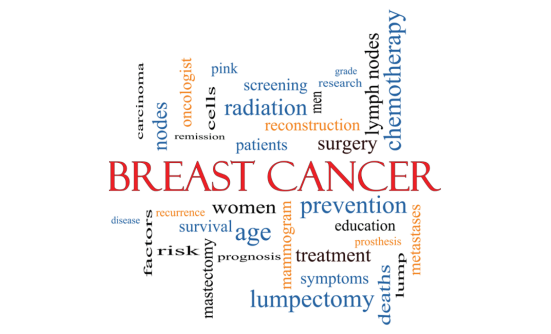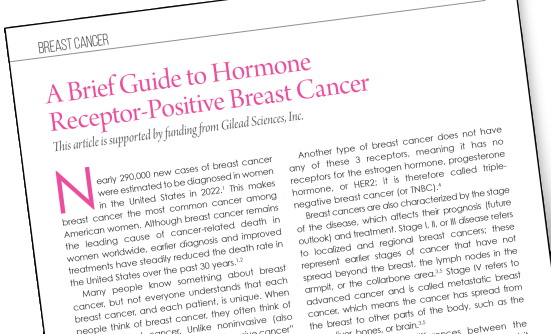A breast cancer diagnosis is challenging for many reasons, and for patients there is the special challenge of learning the medical language that pertains to their diagnosis. The information can be overwhelming, and there are many moving pieces in the care journey. Researching new terms on the Internet can lead to misinformation and increased fear, but a trustworthy guide of terms pertaining to their disease can help breast cancer patients feel more fluent in understanding their condition and more confident in their treatment.
Types of Breast Cancer
Different types of breast cancer are defined by where the cancer cells started growing and whether they have grown into the surrounding breast tissue.
Invasive Lobular Carcinoma
- Breast lobules are glands where milk is produced. Cancer that begins in the lobule and grows out into surrounding breast tissue is called invasive lobular carcinoma.
Ductal Carcinoma In Situ
- Ducts within the breast are thin tubes that carry milk from the lobules to the nipple. The growth of abnormal cells that start in the lining of the duct but have not grown into surrounding breast tissue is called ductal carcinoma in situ (DCIS) and is considered stage 0. There is no way of knowing whether DCIS will become invasive. Because we know that some DCIS lesions will become invasive, it’s important that it’s treated.
Invasive Ductal Carcinoma
- Cancer that starts in the lining of the duct and grows into surrounding breast tissue is called invasive ductal carcinoma.
Metastatic Breast Cancer
- When breast cancer cells move to other parts of the body, such as bones, liver, lungs, or brain, it is called metastatic breast cancer. This is considered stage IV breast cancer.
Staging of Breast Cancer
Staging is a system that is used to determine and describe the extent of cancer in the body. Stage ranges from 0 (DCIS) to IV (cancer cells have spread to other parts of the body). Knowing the stage is important because doctors will use this information to determine the best treatment plan. Staging is primarily based on tumor size and whether the cancer has spread to the lymph nodes or other parts of the body. Doctors may use a pathology report in combination with imaging such as x-ray, CT scan, MRI, or PET/CT to determine staging.
Grading of Breast Cancer
Grades are reported by using a combination of characteristics that are seen by a pathologist when tumor cells are viewed through a microscope. The more cancer cells that look like normal cells, the lower the grade (these cells are also called well differentiated). Cancer cells that look very different from normal cells are considered high grade (also called poorly differentiated). Grades range from 1 to 3 and help to predict how aggressive a tumor is and how likely it is to recur. Typically, the higher the grade, the more likely it is to recur.
- Grade 1: Low grade
- Grade 2: Intermediate grade
- Grade 3: High grade.
Markers and Tests
Breast cancer cells may contain certain proteins that are estrogen (ER), progesterone (PR), or human epidermal growth factor receptor 2 (HER2) receptors. Determining receptor status is important for selecting the most appropriate treatment options. Testing for receptor status is performed either on a biopsy sample or when the tissue is removed surgically. Receptor status is either positive or negative.
- ER positive: Breast cancers that have estrogen receptors are called ER positive
- PR positive: Breast cancers that have progesterone receptors are called PR positive
- HER2 positive: Breast cancers that have human epidermal growth factor receptor 2 are called HER2 positive
- Triple negative: Breast cancers that are not ER, PR, and HER2 positive are called triple negative.
Another marker tested for is the Ki-67 protein, which shows how rapidly the breast cancer cells are dividing and forming new cells. The Ki-67 score can range from 1% to 100%. A score of 0% to 2% is called grade 1 or low grade; between 2% and 20% is known as grade 2 or intermediate grade; a score over 20% is known as grade 3 or high grade. A high score indicates rapid tumor growth.
Genomic tests are used to evaluate a sample of the cancer tumor to see how active certain genes are and how likely it is that the cancer will grow and spread. Genomic tests are used to help determine if additional treatments after surgery will be beneficial. Two such tests are discussed below.
The Oncotype DX test analyzes the activity of 21 genes to determine the likelihood that the patient will benefit from chemotherapy if he or she has an early-stage invasive breast cancer, and whether the breast cancer is likely to return. Oncotype DX eligibility is based on stage, receptor status, and whether the cancer has spread into the lymph nodes.
MammaPrint is another genomic test that analyzes the activity of 70 genes and calculates a recurrence score that indicates either low or high risk. MammaPrint eligibility is based on age, size of cancer, grade, and whether the cancer has spread into the lymph nodes.
Surgical Treatments
Lumpectomy is a surgical procedure to remove cancer from the breast in which only a portion of the breast is removed. A small amount of normal tissue around the lump, called a margin, is also taken to ensure that all cancer and abnormal tissue is removed. This procedure can also be referred to as breast-conserving surgery.
Mastectomy is a surgical procedure to remove all breast tissue from a breast. There are several types of mastectomies, including simple, modified radical, radical, nipple sparing, and skin sparing.
Partial mastectomy is a surgical procedure that is a lumpectomy surgery in which more tissue is removed than in a standard lumpectomy.
Breast reconstruction is surgery, typically performed by plastic surgeons, that restores the breast to near normal shape, appearance, symmetry, and size after a mastectomy. Breast reconstruction includes multiple procedures performed in stages and can start during the time of the mastectomy or be delayed. Implant-based reconstruction uses breast implants to help form a new breast. Flap-based reconstruction uses a patient’s own tissue from another part of the body to form a new breast.
Therapeutic Treatments
There are several types of therapies used to fight cancer, including medical and radiation treatments, hormonal therapies, and immunotherapies. Some common definitions include:
- Neoadjuvant therapy: Treatment that is given as the first step of cancer therapy to help shrink a tumor before the definitive treatment, which is surgery. It can also be called induction therapy
- Adjuvant therapy: Additional treatments given after surgery to lower the risk of recurrence
- Targeted therapy: A treatment that uses chemotherapy that identifies and attacks specific cancer cells with less harm to normal cells. Targeted therapies can:
- Block the growth and spread of cancer cells by blocking the action of certain types of enzymes and proteins
- Help the immune system kill cancer cells
- Deliver toxic substances to the cancer cells to kill them.
Chemotherapy is treatment with anticancer medications that travel through the blood to cells in the body to help decrease and prevent the growth of cancer. Chemotherapy is typically given directly into the bloodstream via a tube placed into the veins or a port; however, there are some types of chemotherapies that are taken by mouth.
Radiation therapy uses high-energy radiation from x-rays, gamma rays, neurons, protons, or other sources to shrink tumors and kill cancer cells. Breast radiation may come from a machine outside of the body (external beam radiation) or from a radioactive material placed in the breast near cancer cells (internal radiation or brachytherapy).
Hormonal therapy is treatment that adds, blocks, or removes hormones that are responsible for cancer growth. Aromatase inhibitors are a common hormonal therapy that helps prevent the formation of estradiol in postmenopausal women who have ER-/ PR-positive tumors. Tamoxifen is a common hormonal therapy in premenopausal women that blocks the effect of estrogen in the breast tissue and may help keep breast cancer from growing.
Immunotherapy is a treatment that uses substances, made either naturally in the body or in a lab, that can stimulate or suppress the immune system to help the body fight off cancer cells. Some common types of breast immunotherapies include targeted antibodies (trastuzumab, pertuzumab) and immunomodulators (atezolizumab).
Conclusion
Receiving a breast cancer diagnosis can be overwhelming. Taking in and digesting so many details, while often still reeling from the words “You have breast cancer,” may seem impossible. However, understanding the diagnosis and treatment options is an important step toward empowering patients to be an active participant in their cancer journey.
Sources
- Breastcancer.org. Breast cancer tests: screening, diagnosis, and monitoring. www.breastcancer.org/symptoms/testing/types. Updated February 6, 2020. Accessed February 10, 2020.
- National Cancer Institute. NCI dictionary of cancer terms. www.cancer. gov/publications/dictionaries/cancer-terms. Accessed February 10, 2020.
- OncoLink. Breast cancer: the basics. www.oncolink.org/cancers/breast/breastcancer- the-basics. Updated January 20, 2020. Accessed February 10, 2020.















